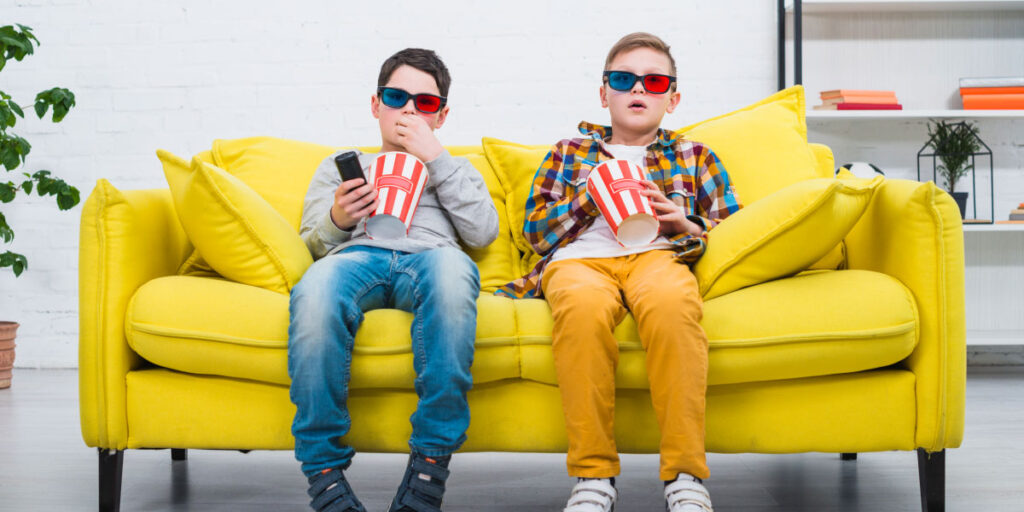In 1998, a 37-year-old woman was fatally stabbed in her apartment in Los Angeles. During the investigations, it was revealed that the culprits were in fact her 14- and 16-year-old son and nephew. They said that they got the idea from watching the two “Scream” slasher movies. The reason, they claimed, was that they wanted to buy a Ghostface mask that they couldn’t afford. Unfortunately, this is not the only example of TV violence affecting children.
Download and Start Your Free Trial of the Safes Parental Control App
In a paper published by Wiley, researchers showed two sets of violent and non-violent films to several 4- and 5-year-olds. They measured their Galvanic Skin Response (GSR) while watching the films. GSR, or emotional sweating, refers to the changes that occur in the sweat glands when someone is emotionally aroused. Results showed that the children showed higher GSR rates while watching violent films. This research shows that violence exposure may have effects on children that should be taken seriously.
In the following sections, we will talk about some of the effects of violent media on youth and ways you can minimize them.
Does Media Violence Affect Children’s Behavior?
The answer is a firm yes. Here are some of the negative effects of media violence on children’s behavior:
Desensitization to Violence
One of the negative effects of media violence on children is desensitization to violence. It means that seeing a lot of violent acts on TV makes kids underestimate their severity. We can all relate to this: Zombie films are old news now. But I remember that the first time I saw a zombie film, I was extremely thrilled and I couldn’t stop thinking about it for days.
This is also supported by scientific evidence: A violent movie was shown to 121 children of 5-14 years old. Researchers found that children with a history of high exposure to TV violence were significantly less affected emotionally by the violence than those with less exposure history.

Thinking That Violence Is Cool
A benevolent superhero, a rich man with a cool costume scanning the city to fight bad criminals, spilling their blood on the floor and smashing their heads; these are the barrage of imagery the movie industry uses to attract the most audience possible. Our children have a strong sense of imagination. Seeing all these cool heroes can encourage them to be more like these characters.

Long-Term Effects
Does television violence cause aggression? Apparently yes. Exposing children to TV violence at an early age will increase the chance of aggression in adulthood. Children learn from their surroundings. Their personalities are a result of their upbringing and external factors that they’ve been exposed to. Seeing a lot of violence on TV habituates their developing brains to aggressive behavior. This exposure can show its effects years later.
Protecting Your Child From TV Violence
Here’s what we suggest that you do to protect your child from the adverse impacts of TV violence:
Research Channels and Programs Beforehand
Sometimes, you might just turn the TV on and switch channels mindlessly until something catches your eye. While this can be okay while you’re alone, it might not be a great idea when you’re with your child. A TV program can seem innocent at first glance, but what are you going to do if something inappropriate pops up on the screen?
The best way to avoid this kind of problem is to look the channel or program up before settling for something. Are adults the TV channel’s only target audience? Does the movie contain scenes that your child shouldn’t see? Looking this up only takes a few minutes. So don’t panic.
Check Out the Shows’ Age Ratings
Not all TV shows are suitable for your child. You should only let them watch the ones that are appropriate for their age. The age rating system is a system that defines whether a certain movie is appropriate for different age groups. Each movie belongs to a certain category, which will tell you whether your child can watch it or not. Here are the five age rating categories and their meanings.
Also, most TV shows warn the audience when they contain explicit language or content. In that case, you will have to decide whether it targets your child’s age group or not.
Use Parental Controls on Your TV
You might not always be with your child to supervise what they watch on TV. Parental controls are a modern solution to modern parenting problems. By setting up parental controls on your TV, you can make sure they don’t watch programs that are not suitable for their age. Learn how to set up parental controls on different brands of TV here.
Parents, Beware!
A little bit of additional information: TVs aren’t the only way your child can watch movies or TV shows. In fact, TV popularity has decreased significantly among the younger generation. Nowadays, streaming services such as Netflix or Hulu offer a wide variety of content that your child can access via their electronic devices. You can minimize TV violence effects on your child by installing parental control apps on their devices. Safes is a parental control app that offers various adjustable features covering all your online child safety needs. You can easily set it up on your child’s phone and computer and start your free trial.
Your Child’s Online Safety Starts Here
Every parent today needs a solution to manage screen time and keep their child safe online.
Without the right tools, digital risks and excessive screen time can impact children's well-being. Safes helps parents set healthy boundaries, monitor activity, and protect kids from online dangers—all with an easy-to-use app.
Take control of your child’s digital world. Learn more about Safes or download the app to start your free trial today!




